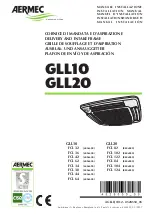
6 Installation
Installer and user reference guide
19
RXYTQ8~16U7YF
VRV IV+ heat pump for high ambient temperatures
4P561157-1 – 2018.09
▪ Fasten the unit in place using four foundation bolts M12. It is best
to screw in the foundation bolts until their length remains 20 mm
above the foundation surface.
20 mm
NOTICE
▪ Prepare a water drainage channel around the
foundation to drain waste water from around the unit.
During heating operation and when the outdoor
temperatures are negative, the drained water from the
outdoor unit will freeze up. If the water drainage is not
taken care of, the area around the unit might be very
slippery.
▪ When installed in a corrosive environment, use a nut
with plastic washer (a) to protect the nut tightening part
from rust.
a
6.4
Connecting the refrigerant piping
6.4.1
Precautions when connecting the
refrigerant piping
NOTICE
Make sure refrigerant piping installation complies with
applicable legislation. In Europe, EN378 is the applicable
standard.
NOTICE
Make sure the field piping and connections are NOT
subjected to stress.
WARNING
During tests, NEVER pressurize the product with a
pressure higher than the maximum allowable pressure (as
indicated on the nameplate of the unit).
WARNING
Take sufficient precautions in case of refrigerant leakage. If
refrigerant gas leaks, ventilate the area immediately.
Possible risks:
▪ Excessive refrigerant concentrations in a closed room
can lead to oxygen deficiency.
▪ Toxic gas may be produced if refrigerant gas comes
into contact with fire.
WARNING
ALWAYS recover the refrigerant. Do NOT release them
directly into the environment. Use a vacuum pump to
evacuate the installation.
▪ Only use phosphoric acid deoxidised seamless copper.
NOTICE
After all the piping has been connected, make sure there is
no gas leak. Use nitrogen to perform a gas leak detection.
6.4.2
About connecting the refrigerant piping
Before connecting the refrigerant piping, make sure the outdoor and
indoor units are mounted.
Connecting the refrigerant piping involves:
▪ Routing and connecting the refrigerant piping to the outdoor unit
▪ Protecting the outdoor unit against contamination
▪ Connecting the refrigerant piping to the indoor units (see the
installation manual of the indoor units)
▪ Connecting the multi-connection piping kit
▪ Connecting the refrigerant branching kit
▪ Keeping in mind the guidelines for:
▪ Brazing
▪ Using the stop valves
▪ Removing the pinched pipes
6.4.3
To route the refrigerant piping
Installation of refrigerant piping is possible as front connection or
side connection (when taken out from the bottom) as shown in the
figure below.
a
b
c
a
Left-side connection
b
Front connection
c
Right-side connection
For side connections, the knockout hole on the bottom plate should
be removed:
c
b
a
a
Large knockout hole
b
Drill
c
Points for drilling
NOTICE
Precautions when making knockout holes:
▪ Avoid damaging the casing.
▪ After making the knockout holes, we recommend you
remove the burrs and paint the edges and areas
around the edges using repair paint to prevent rusting.
▪ When passing electrical wiring through the knockout
holes, wrap the wiring with protective tape to prevent
damage.
6.4.4
To connect the refrigerant piping to the
outdoor unit
INFORMATION
All local inter unit piping are field supplied except the
accessory pipes.
















































